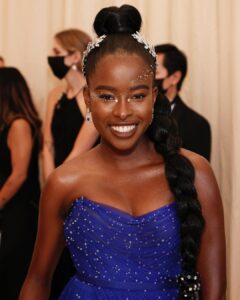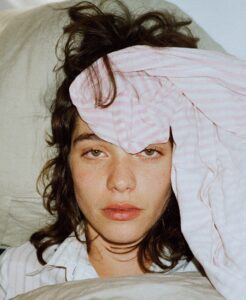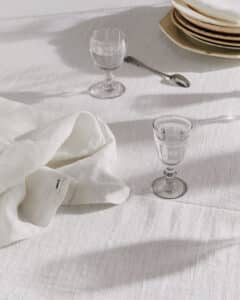JamJar Flowers is based in South London and is responsible for some of the most outlandish flower installations that you may have seen around town. They have built badminton players out of flowers, a ceiling from hanging flowers, and 3D printed pressed flowers to be made into a wallpaper, amongst many other noteworthy projects.
Since it was founded in 2009, the company has constantly evolved, encompassing workshops to attend, homeware goods, projects with fashion labels like Mulberry, collaborations with artists, and beautiful pressed flower pieces.
Melissa, whose love for flowers grew out of her childhood spent in her family’s garden in Sussex, speaks to Lula about the reality behind these impossible creations – her secret is her ambitious and brave creative team – and gives you advice on getting the best from your flowers.
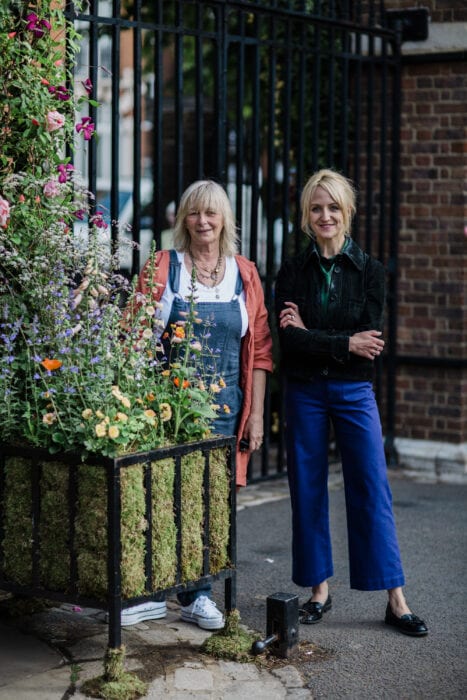
Where does your love of flowers come from?
I grew up in a lovely place. A huge but ramshackle Elizabethan long house with wonderful gardens surrounded by soft red brick walls. Beyond the gardens lay the woods and fields full of wild flowers. We were allowed to spend all our time roaming the countryside. We just had to be home for meals. My father was a gifted gardener and spent all the time he had, away from the city where he worked, making the garden more beautiful. When we were little he took us out into the woods and showed us how to pick wild flowers. Just one flower from each clump of primroses. When you are encouraged to look at flowers and nature from a young age, as I was, the love of flowers just comes naturally.
Why did you decide to open JamJar Flowers? And what was the transition like from running your modelling agency Take Two to JamJar Flowers?
After 27 years of running Take Two Model Management, a successful high fashion model agency, we decided that we had reached the end of the line. The model business was not as amusing as it used to be and we were finding it quite stressful and less financially rewarding so we decided to close the agency, pay our bills and walk away. I decided to start JamJar Flowers from my kitchen table. I wanted a simpler and less anxious lifestyle but I did know I would need some kind of a job to keep me sane. The idea was to do something completely different, but in fact, within a short time, I discovered that running any business requires almost the same skills. A cool head, a close eye on the numbers at all times, a team, some charm and excellent sales manner. The great difference with working with flowers is the pleasure of making something beautiful with your hands and surrounding yourself with lovely, clever, talented, creative people. But it was mostly the flowers… season after season of beautiful flowers, an unexpected joy of which I never tire.
Have you noticed a shift in how people buy flowers in recent months?
The major shift for us has been the lack of events. We don’t have a shop and our entire business has been built on events and weddings so there has been a major downturn in turnover and we are having to be very inventive to keep on going. The upside is that making flowers for tiny microweddings is a delight. Having time to make sure every detail is perfect. People are sending flower deliveries to their friends and family who are often feeling isolated and sad. I think we all really enjoy the personal aspect of trying to get the flowers just right for the receiver. To bring pleasure to people’s homes feels like a luxury. I am constantly awed and amazed by the endless invention of our core team.
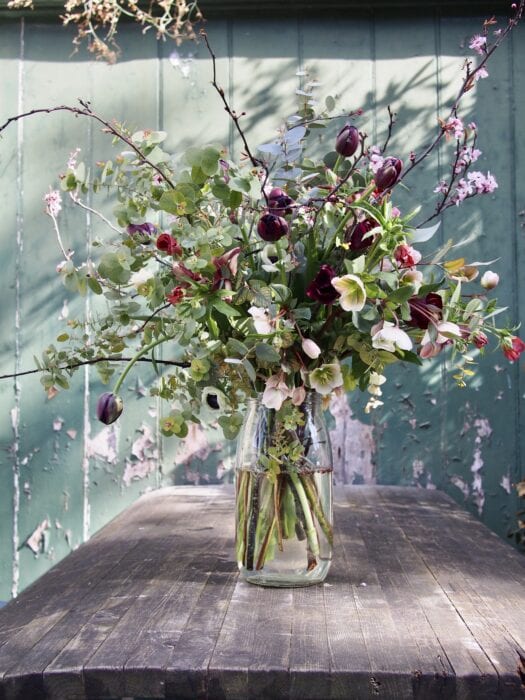
With a project like Badminton House, what was your starting point? And how were you able to create those amazing flower women?
We were invited to make an installation for a private event at Badminton House by the brilliant and eccentric Mary Lynn VanWyck of US events company VanWyck VanWyck. She gave us a free rein to come up with a concept for the North Hall at Badminton House where the guests would arrive for the party. Once we realised that the North Hall was actually where the game of Badminton was invented in 1873 I just had this idea that we could make some oversized victorian badminton players with shuttlecocks flying through the air. All made of flowers. We settled down with Leila Watts, an astonishingly talented model maker, (she made all the prototypes for Netflix’s The Big Flower Fight) and came up with a concept. Two giant female figures made of fresh and dried flowers on podiums playing an energetic game of badminton. [John Pickersgill] made the podiums and the bases for the badminton girls, out of wood. Then Leila sculpted the figures out of chicken wire and they were fitted over the wooden structures. Then came the task of filling the chicken wire with dried flowers. A seemingly endless task. Where the skirts flicked up we used white limonium and gypsophila to show as petticoats. The problem of the flying shuttlecocks was sorted out at the last minute by my son Finn with tensile wire. A trajectory of shuttlecocks flying through the air in a parabolic arc to add movement and speed to the piece. I still don’t quite know how he managed it.
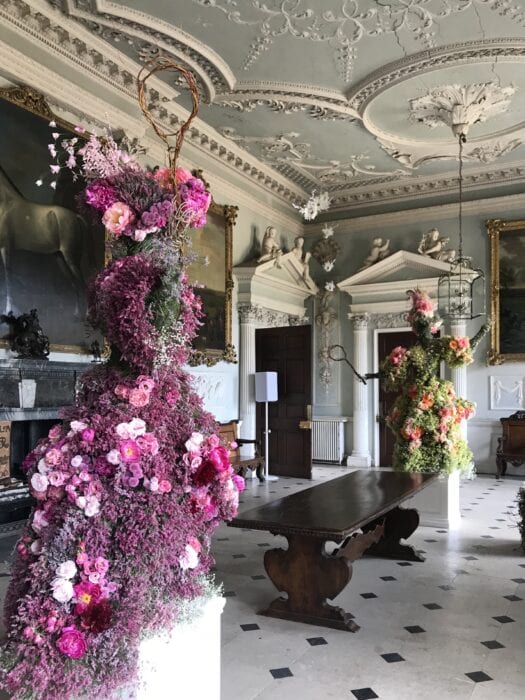
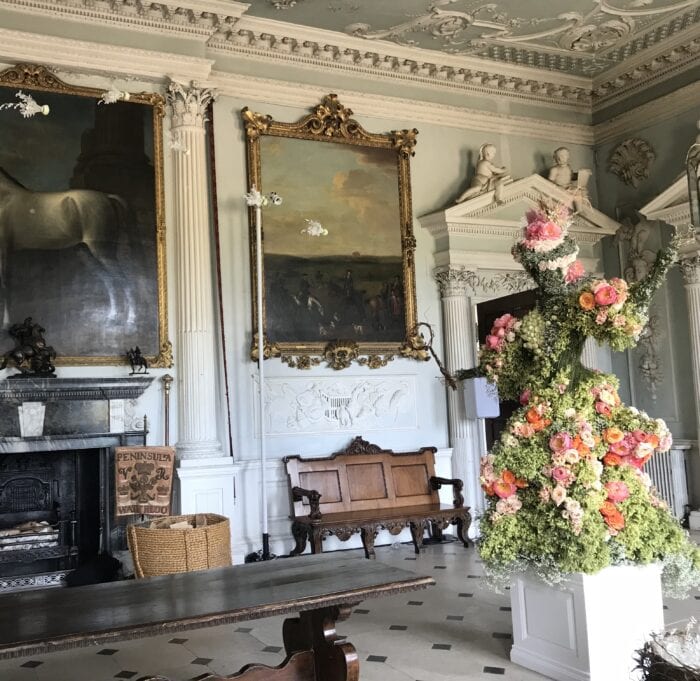
Can you tell me more about your collaborations with Sketch? How did you come up with the amazing ideas for the restaurant?
We have done four projects at Sketch for Mayfair in Bloom. All have been pretty ambitious. The first in 2016 was a hanging ceiling of 60,000 flowers in the Glade. A terrifying project. We tested which flowers worked best, drying out upside down, in the studio, then put in our massive flower order to Graeme Diplock at Zest Flowers in New Covent Garden Flower Market. At one point the art director Sylvain Chevalu came down and looked gloomily at the piece and said it will never work: “it’s too dark”. But with brilliant lighting by Joel at Sketch and the last minute installation of all the bold colour, it worked brilliantly. There are photos of Finn, Amy and me on the morning after and we look utterly exhausted. Dashing through; two more Sketch installations. The 2017 May Fair, a rendition of the original May Fair – from which Mayfair gets its name – complete with Maypole. The following May, we decorated the whole facade of the building in Conduit Street to look like a Rajasthani Palace using pressed and dried flowers.
In 2019 Sylvain Chevalu once again trusted us to come up with an idea for Sketch, Mayfair in Bloom. This time the theme was “Arts and Crafts”. Using William Morris’s Red House as a loose inspiration Amy and I decided to make pressed flower stained glass windows. We used a sheet of opaque perspex and a sheet of clear we pressed the flowers in between the two and lit it softly from behind to create the stained glass window effect. We pressed masses of rose leaves from my garden and jasmine from our yard to create drifts of foliage. In pride of place went our first successful pressed tulips. We wanted the viewers not to be certain if it was stained glass or nature pressing up against the windows. Again it was an overnight install. Not easy but the results were lovely. It really felt like sitting in an arts and crafts conservatory.
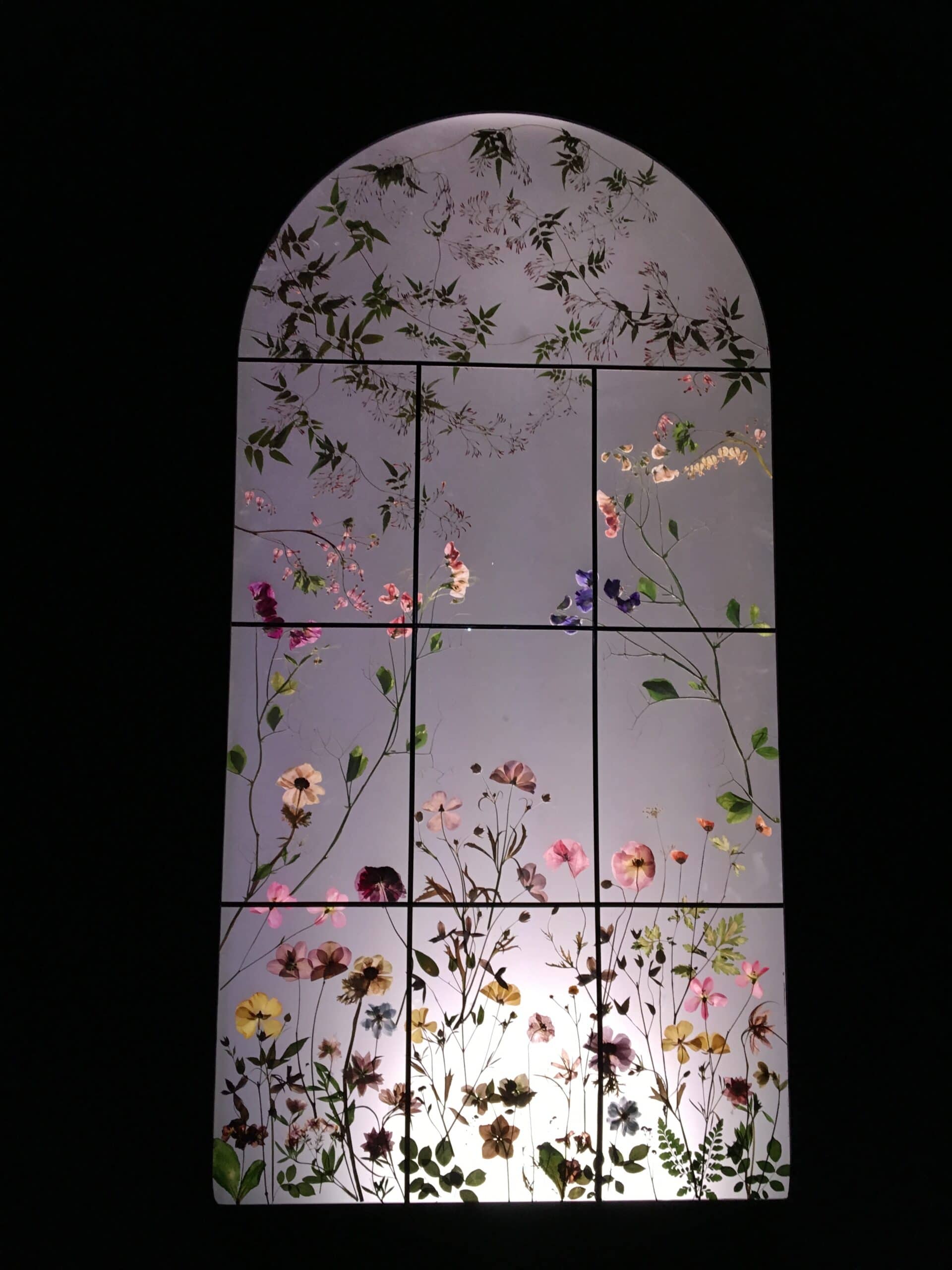
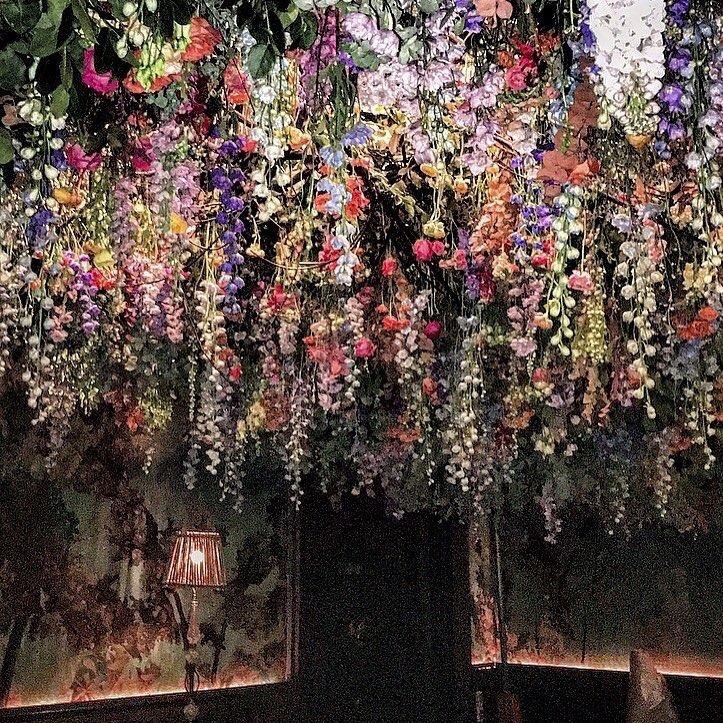
What was your most eccentric request from a client? Have you ever been worried about not being able to carry out the project?
Probably the most eccentric request was a 2 meter high day of the dead skull commissioned by Juliet Mayhew for a New Years Party on Tower Bridge. It was particularly challenging as we had about an hour to get it in position. Between the tourists leaving and the party starting, it could hardly fit in the lift and carrying this giant skull through crowds of New Year’s Eve revellers on Tower Bridge was a challenge in itself.
What is your most frightening?
Certainly our most frightening challenge was dressing The London Gate for the 2019 Chelsea Flower Show for the RHS. Once again I had an idea and then frightened myself senseless as to how it was ever going to work. We wanted to create a gigantic theatre curtain so people could walk through the curtain and into the magic flowery world beyond.
We wanted the curtain to look soft and fluid so Scotscape removed the heavy backing because it only had to last a week and they knew we would be assiduous about the watering. We used different flowering herbs to create the different shades of green to give the illusion of folds. Then a tie back of golden and plum coloured heuchera. In the end we created a gorgeous crown of clematis and Albertine roses provided by the brilliant Peter Beale. We filled the curtain, borders and pelmet with bee friendly flowers.
The message was “The hum of bees is the voice of the garden” a lovely quote by Elizabeth Lawrence found for us by Ella Bandtock our studio manager. The curtain was studded with giant bees made again by our favourite collaborator Leila Watts. We wanted our installation to be both a celebration of bees and also a message that without them we would be pretty much doomed. I suppose the reason this project frightened me more than any other is that I am a very sketchy gardener myself. I am much more comfortable with using dried or cut flowers. In the end it was a huge success. I think it was my proudest moment so far.
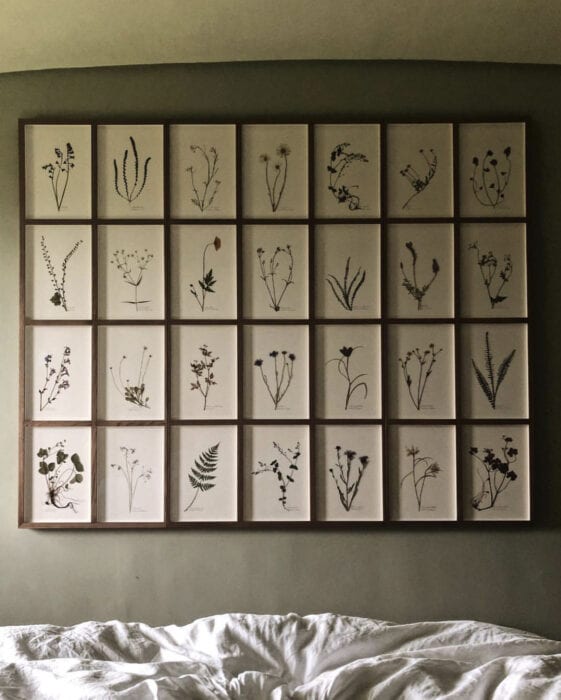
How do you approach a flower arrangement? Or a composition for pressed flowers? Can you give any advice?
I think it’s not very hard to be a florist but it is really difficult to be a good florist. Some of the people we work with are really artists like our head florist Talena Rolfe. She has a gorgeous eye and takes an enormous amount of trouble and time to realise her vision. Whether it is a flower arrangement or a pressed flower piece it is all about taking the time and finding the right ingredients. It is important to work with the natural shape of the flower. It sounds obvious, but the best florists seek out the flowers with the best shapes. Flowers that have leaned out and twisted to catch the light or a beautiful piece of foliage that has just been tinted by autumn colour can elevate a piece from ordinary to sublime. In spring and summer we love to use British flowers that have been grown outdoors. They have personality unlike their cousins who have been grown in serried ranks in polytunnels. They will bring the joy of the garden and individuality to your arrangements.
What flowers are good to use now as we get into Winter?
Evergreen foliage is never better than in the winter. In the autumn curly chrysanthemums are really the last garden flowers. Use seed heads, berries, dried flowers like helichrysum and achillea and grasses to mirror the season. Flowers are in short supply at this time of year but it is a reasonably sustainable option to buy spring flowers which have been forced in poly tunnels in Holland and Italy. Soon anemones and ranunculus and hellebores will arrive in the market. All JamJar favourites.
Is there anything you wish more people knew about flowers?
Oh god yes! My husband says I am a nightmare in other people’s houses. I am always rearranging their flowers, whisking leaves out of the water, topping up the water et cetera. Very rude apparently. But to me flowers are living things. Once we have cut their stems we have already shortened their lives. It is not possible for me to enjoy flowers which are standing in stagnant water, or where leaves are rotting below the water line, or when they are hanging their heads in their death throes. Refresh the water often, recut the stems if they get too tall. A lot of spring flowers continue to grow in the vase and need cutting back occasionally. Don’t stand them in direct sunlight. Remove dead flowers, they are just killing the others in the vase. Be aware. They are only around for a very short time and they are miraculous. Stop. Take time. Stand and stare. There is much to be seen and to learn about in a bunch of flowers.
Photos courtesy of JamJar Flowers




